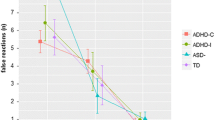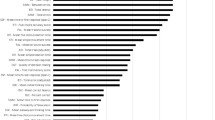Abstract
The validity of the DSM-IV subtypes is a recurring diagnostic debate in attention deficit/hyperactivity disorder (ADHD). Laboratory measures, such as the test of everyday attention for children (TEA-Ch) can help us address this question. TEA-Ch is a test battery covering different aspects of everyday attention relating to selective and sustained attention and attentional control. The aim of the current study was to investigate whether this instrument can differentiate between combined (ADHD-C) and inattentive subtype (ADHD-I) of ADHD. Subjects were recruited from a multidisciplinary ADHD outpatient unit and tested free of medication. Sixty-four children with a diagnosis of ADHD were included (38 with ADHD-C; 26 with ADHD-I). The control group was 76 children recruited from primary and secondary schools. Children with ADHD performed worse than controls on 6 out of 9 TEA-Ch subtests. However a regression analysis revealed that TEA-Ch subtests made only a marginal contribution to the correct classification of ADHD, once the effects of IQ and age are controlled. Confirmatory factor analysis in our ADHD group demonstrated that the three factor structure achieved a poor fit. More detailed analysis suggested that inferior performance on the tasks designed to test vigilance was not the result of deficient-sustained attention. ADHD-C and ADHD-I showed very few differences across tasks. In conclusion, our results provided not much support for the value of the ADHD-C and ADHD-I distinction in predicting difficulties in everyday attention.
Similar content being viewed by others
References
American Psychiatric Association (2000) Diagnostic and statistical manual of mental disorders (4th Ed. Text Revision). Author, Washington, DC
Baeyens D, Roeyers H, Walle JV (2006) Subtypes of attention-deficit/hyperactivity disorder (ADHD): distinct or related disorders across measurement levels? Child Psychiatry Hum Dev 36:403–417
Barkley RA (1997) ADHD and the nature of self control. Guilford Publisher, New York
Barkley RA (1997) Behavioral inhibition, sustained attention, and executive functions: constructing a unifying theory of ADHD. Psychol Bull 121:65–94
Barkley RA, Cook EH, Diamond A, Zametkin A, Thapar A, Teeter A et al (2002) International consensus statement on ADHD—January 2002. Clin Child Family Psychol Rev 5:89–111
Bollen KA, Long JS (1993) Testing structural equation models. Sage, Newbury Park
Carlson CL, Tamm L, Gaub M (1997) Gender differences in children with ADHD, ODD, and co-occurring ADHD/ODD identified in a school population. J Am Acad Child Adolesc Psychiatry 36:1706–1714
Collings RD (2003) Differences between ADHD inattentive and combined types on the CPT. J Psychopathol Behav Assess 25:177–189
Gaub M, Carlson CL (1997) Behavioral characteristics of DSM-IV ADHD subtypes in a school-based population. J Abnorm Child Psychol 25:103–111
Geurts HM, Verte S, Oosterlaan J, Roeyers H, Sergeant JA (2005) ADHD subtypes: do they differ in their executive functioning profile? Arch Clin Neuropsychol 20:457–477
Heaton RK, Chelune GJ, Talley JL, Kay GG, Curtis G (1993) Wisconsin card sorting test (WCST) manual, revised and expanded. Psychological Assessment Resources, Odessa
Heaton SC, Reader SK, Preston AS, Fennell EB, Puyana OE, Gill N, Johnson JH (2001) The test of everyday attention for children (TEA-Ch): patterns of performance in children with ADHD and clinical controls. Child Neuropsychol 7:251–264
Hinshaw SP (2001) Is the inattentive type of ADHD a separate disorder? Clin Psychol Sci Pract 8:498–501
Hood J, Baird G, Rankin PM, Isaacs E (2005) Immediate effects of methylphenidate on cognitive attention skills of children with attention-deficit-hyperactivity disorder. Dev Med Child Neurol 47:408–414
Houghton S, Douglas G, West J, Whiting K, Wall M, Langsford S, Powell L, Carroll A (1999) Differential patterns of executive function in children with attention-deficit hyperactivity disorder according to gender and subtype. J Child Neurol 14:801–805
Kaufman J, Birmaher B, Brent D, Rao U, Flynn C, Moreci P, Williamson D, Ryan N (1997) Schedule for affective disorders and schizophrenia for school-age children-present and lifetime version (K-SADS-PL): initial reliability and validity data. J Am Acad Child Adolesc Psychiatry 36:980–988
King C, Young D (1982) Attentional deficits with and without hyperactivity: teacher and peer perceptions. J Abnorm Child Psychol 10:483–496
Klorman R, Hazel-Fernandez LA, Shaywitz SE, Fletcher JM, Marchione KE, Holahan JM et al (1999) Executive functioning deficits in attention-deficit/hyperactivity disorder are independent of oppositional defiant or reading disorder. J Am Acad Child Adolesc Psychiatry 38:1148–1155
Kort W, Schittekatte M, Dekker PH, Verhaeghe P, Compaan EL, Bosmans M, Vermeir G (2005) Nederlandse bewerking van de WISC-III: handleiding en Verantwoording. Harcourt Test Publisher, Amsterdam
Lockwood KA, Marcotte AC, Stern C (2001) Differentiation of attention-deficit/hyperactivity disorder subtypes: application of a neuropsychological model of attention. J Clin Exp Neuropsychol 23:317–330
Lollar DJ (2008) Function, impairment, and long-term outcomes in children with ADHD and how to measure them. Pediatr Ann 37:6–28
Manly T, Anderson V, Nimmo-Smith I, Turner A, Watson P, Robertson IH (2001) The differential assessment of children’s attention: the test of everyday attention for children (TEA-Ch), normative sample and ADHD performance. J Child Psychol Psychiatry 42:1065–1081
Manly T, Roberston IH, Anderson V, Nimmo-Smith I (2004) Handleiding van de test of everyday attention for children, Nederlandse vertaling. Harcourt Test Publishers, Amsterdam
Milich R, Balentine AC, Lynam DR (2001) ADHD combined type and ADHD predominantly inattentive type are distinct and unrelated disorders. Clin Psychol Sci Pract 8:463–488
Nigg JT (2006) What causes ADHD? Understanding what goes wrong and why. Guilford Publications, New York
Nigg JT, Blaskey LG, Huang-Pollock CL, Rappley MD (2002) Neuropsychological executive functions and DSM-IV ADHD subtypes. J Am Acad Child Adolesc Psychiatry 41:59–66
Parasuraman R, Warms JS, See JE (1998) Brain systems of vigilance. In: Parasuraman R (ed) The attentive brain. MIT Press, Cambridge, pp 221–256
Posner MI, Petersen SE (1990) The attention system of the human brain. Annu Rev Neurosci 13:25–42
Reitan RM, Wolfson D (1985) The Halstead–Reitan neuropsychological test battery. Neuropsychology Press, Tucson
Schwartz K, Verhaeghen P (2008) ADHD and Stroop interference from age 9 to age 41 years: a meta-analysis of developmental effects. Psychol Med 38:1607–1616
Skansgaard EP, Burns GL (1998) Comparison of DSM-IV ADHD combined and predominantly inattention types: convergent and discriminant validity between teacher ratings and direct observations of inattentive, hyperactivity/impulsivity, slow cognitive tempo, oppositional defiant, and overt conduct disorder symptoms. Child Fam Behav Ther 20:1–14
Sutcliffe PA, Bishop DVM, Houghton S (2006) Sensitivity of four subtests of the test of everyday attention for children (TEA-Ch) to stimulant medication in children with ADHD. Educ Psychol 26:325–337
van der Meere J, Wekking E, Sergeant J (1991) Sustained attention and pervasive hyperactivity. J Child Psychol Psychiatry 32:275–284
van Mourik R, Oosterlaan J, Sergeant JA (2005) The Stroop revisited: a meta-analysis of interference control in AD/HD. J Child Psychol Psychiatry 46:150–165
Willcutt EG, Doyle AE, Nigg JT, Faraone SV, Pennington BF (2005) Validity of the executive function theory of attention-deficit/hyperactivity disorder: a meta-analytic review. Biol Psychiatry 57:1336–1346
Acknowledgments
The authors thank all participants, parents and their schools for their willing collaboration. We thank Joke Dillen and Elsbeth Kenens for assistance with data collection and Katrien Verstraeten for assistance with the confirmatory factor analyses.
Author information
Authors and Affiliations
Corresponding author
Rights and permissions
About this article
Cite this article
Lemiere, J., Wouters, H., Sterken, C. et al. Are children with ADHD predominantly inattentive and combined subtypes different in terms of aspects of everyday attention?. Eur Child Adolesc Psychiatry 19, 679–685 (2010). https://doi.org/10.1007/s00787-010-0105-9
Received:
Accepted:
Published:
Issue Date:
DOI: https://doi.org/10.1007/s00787-010-0105-9




